"Give them an asylum, with good and kind treatment; but not a school."
– Massachusetts Governor Butler, 1883
Shelter the Deviant from Society
The experimental training schools were a success. Seguin's teaching methods for individuals with disabilities led to improvements in their physical development, behavior, and social skills. "Intellectual deficiency" was not "cured" but many pupils with mild and moderate disabilities benefited from their training; they developed the necessary skills to return to their families and community.
Unfortunately, during the economic troubles of 1857 and as a result of the Civil War, there simply were no employment opportunities for returning pupils. Competition for jobs was already high, with immigrants willing to work for low wages. Historian James W. Trent noted, "In a growing and increasingly industrialized nation, communities did not need idiots, not even educated ones." Pupils who returned to their communities looking for work usually ended up in poorhouses or jails.
At the same time, there was an increasing demand for placement in training schools. Many parents had heard success stories and some believed that "intellectual deficiency" could even be cured. Existing training schools expanded their facilities and began serving persons with all types of disabilities.
From Training School to Asylum
While the number of training schools and enrollment increased, and some people believed the schools were successful, the commitment to education was abandoned. Throughout the 1870s and 1880s, a few schools continued to admit persons of a young age who were considered capable of benefiting the most from instruction. However, a much greater concern was housing a growing number of individuals of all ages with all levels of disability.
By 1875, a number of states began building custodial institutions, providing housing and assistance with daily tasks, such as feeding and bathing, but little else. Residents became inmates. In order to exist, these institutions had to change their focus. Rather than educating individuals for life in the community, inmates were trained to work inside the institutions, taught functional skills, and used as laborers to reduce overall operating costs.
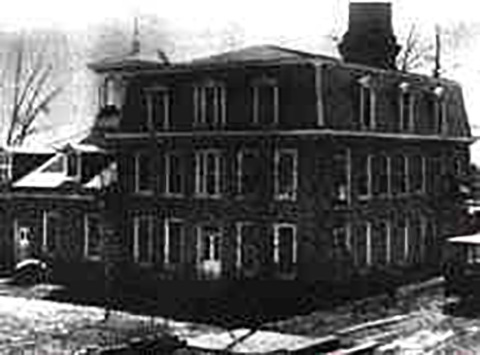
Pennsylvania Training School
Institution superintendents began asking the states to pay for indigent custodial care, arguing that this would relieve communities of their poorhouses and almshouses. Providing persons with disabilities with safety and shelter was the best they could do, and thus began what David Vail later described as the dehumanizing process. These new institutions, located in rural areas and away from the view of most people, no longer encouraged interaction with the community.
This was the beginning of what David Vail later described as the dehumanizing process. Unlike the early training schools, the new institutions no longer encouraged interaction with the community. They were located in rural areas and away from the view of most people.
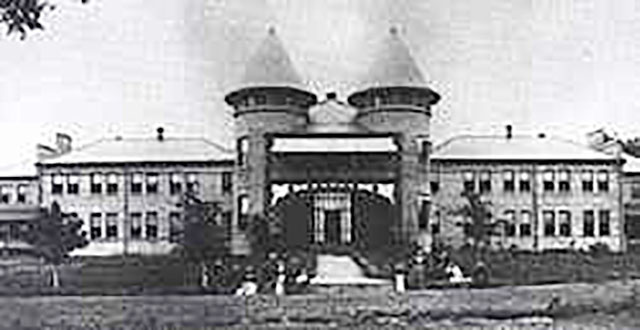
Dehumanization: The Total Institution
(Produced in the mid-1960s). An educational short describing a place of work and/or residence where individuals are separated from the broader community, leading to an isolated and formally administered way of life. (Run time 13:48)
Ralph Spy: Hello? Ralph Spy speaking. Oh, hello Chief. Ah yes, right away, Chief.
Chief: Spy, we've got a problem. DE is on the rampage.
Ralph Spy: DE?
Chief: DE!
Ralph Spy: You mean "may"!
Chief: Here this is a checklist from Central Intelligence on DE.
Ralph Spy: Hmm, looks like "Ed"…
Chief: Spy, that's upside down.
Ralph Spy: Sorry, chief. Oh yes, DE, hmm, the International degrading of words, in the words meaning less than… What's that got to do with me, Chief?
Chief: They've started on a really good word - "humanization".
Ralph Spy: You mean they've add a DE to that?
Chief: They've added DE to humanization.
Ralph Spy: Where?
Chief: In front of it, and now we've got to find out how and, most important, why.
Ralph Spy: Anything to go on, Chief?
Chief: Not any more than it's been going on for a long time.
Ralph Spy: I'll be alone?
Chief: No Spy, get Invisible Agent Five to help you.
Ralph Spy: Aww, chief!
Chief: I said get A5.
A5: You need help again, Spy?
Chief: A5, help Spy with this one. I know you've been interested in this for a long time.
A5: Thanks Chief, this is a problem that needs better understanding. I'd be glad to help.
Chief: A5, thanks.
Ralph Spy: Chief, I'm sure I can handle this alone.
Chief: A5, please?
A5: DE, the arch enemy of human dignity.
A5: Ralph Spy, quick at pointing out a problem but not always reasoning why.
A5: The Chief. He's not satisfied just to fix blame, but must first find the cause.
A5: Invisible Agent 5. That's me. I'm never seen, but my power of reasoning influences all decisions.
Ralph Spy: A5, I think this is a ridiculous place to start the investigation.
A5: Quick, Spy, look to your left.
Policeman: [shouting] Look, I told you not to go back, what you gonna do 'bout that!
Ralph Spy: It looks like DE has infiltrated the police force.
A5: Spy, take a look at this.
Ralph Spy: Wowee!
Boss: [yelling]
Employee: Well!
Ralph Spy: DE has gotten into management!
A5: Spy, it isn't just the police or management. We've all been exposed to DE, but we have the opportunity to yell back, laugh at, ignore, or walk away from DE, but in a controlled community this isn't possible.
Ralph Spy: Wait 'til the chief hears about this… controlled communities… Controlled communities?
A5: Controlled communities are total institutions.
Ralph Spy: Aha, total institutions, wonderful! What are total institutions?
A5: You'll understand it better if we take a look at a few total institutions. Let's start with the military.
Ralph Spy: DE is in the military? Why would DE try to infiltrate the military, A5?
A5: Because, Spy, it's one of the easiest places for him to operate. The military is for the most part a total institution.
Ralph Spy: What makes a total institution?
A5: A total institution is a closed world like this army camp, a ship at sea, or a hospital, where the total living experience is within the institutional boundaries.
Ralph Spy: Hmm, that's probably why they have this fence around the camp, A5. Now I understand total institutions.
A5: That's just part of it, Spy. Another feature of a total institution is that a large group is governed by a smaller group who is in authority.
Ralph Spy: You mean like the officers in charge here?
A5: Yes, Spy.
Ralph Spy: But where does DE fit in?
A5: Well let's watch this typical recruit and see.
Ralph Spy: Hmm…
A5: This is a new recruit. Up to the time of his induction he lived a normal civilian life with all the freedom that goes with it. But upon entering the army he becomes more or less just one of a group. He's dressed as a group and treated as a group.
Sergeant: All right, you meat heads… ten hut! Right face… about face… forward march… hut hut hee ho, hut hut hee ho.
A5: The recruit works, eats and sleeps, in a controlled community and is so regimented that he begins to feel less like an individual and more like just one of the batch. That's one of the ways DE is slowly creeping in.
Ralph Spy: I'm beginning to see, A5. This is a vicious plot to dehumanize the American fighting man.
A5: Not quite, Spy, the Army has a rationale or special purpose for setting up the rules and procedures they follow.
Ralph Spy: Yes, to dehumanize the individual.
A5: No, the rationale of the Army is to make soldiers out of a large group of young men in the fastest, easiest way they can. Now, whether they could do it another way may be a legitimate question.
Ralph Spy: Yes and I would like to ask it.
A5: Before you do, let's take a look at another total institution, the prison system.
Ralph Spy: You mean…
A5: Yes, DE is at work in the prisons.
Ralph Spy: Does DE operate in prisons like in the Army?
A5: Yes, in many ways. A person enters a prison because of some crime of his against society, for 2 years, 10 years, 50 years, maybe even for life. He enters as an individual, but soon becomes just one of a total group of inmates that make up the institution. This large group of inmates is in turn governed by a small group of guards and a warden who sets up the rules the inmates are to live by. In the prison files, he has a number instead of a name. His working, eating, sleeping and recreation are a never-changing routine that makes him feel more like a human robot than a human being.
Ralph Spy: Aha, this is where DE comes in.
A5: Well, yes. Through this whole process of rules and regulations, DE tends to make the inmate feel less than an individual.
Ralph Spy: Let's do away with the rules and regulations.
A5: There's nothing wrong with rules regulations, but we should examine them and see if they are accomplishing what we intended them to accomplish. In the case of the prison, the rules are supposed to help make a bad guy into a good guy.
Ralph Spy: Hmm, A5 are there any more total institutions?
A5: Yes let's take a look at the hospitals for the mentally ill and mentally retarded and make a study of the total institution and DE.
Ralph Spy: A5, it's two o'clock, why the ringing bell?
A5: There must be a reason for it.
Ralph Spy: Pardon me, doctor, but that bell - why is it ringing?
Doctor: It always rings at this time.
Ralph Spy: Why?
Doctor: Because… you know, I've never thought about that.
Ralph Spy: Very interesting, doctor. Thank you.
A5: Spy, this is a good example of how practices can be built into total institutions. They're perpetuated, even if no one knows why.
Ralph Spy: You mean that there probably isn't a reason for that bell to ring?
A5: I'm afraid that's it.
Ralph Spy: Nurse, why are these doors locked?
Nurse: Three months ago, a patient tried to escape.
Ralph Spy: So you locked everyone's room because of what one person did three months ago?
Nurse: Yes, but it's for their own good.
Ralph Spy: What'd she mean, for their own good?
A5: The rationale of mental hospitals is treatment, therefore anything that happens to patients can be interpreted as treatment, thus for their own good.
Ralph Spy: Some treatment! Hello ma'am, may I ask what you're doing?
Hospital Administrator: Yes, you may.
Ralph Spy: What are you doing?
Hospital Administrator: It's an annual check we give patients and this is the last of four units to be processed.
Ralph Spy: A5, I'd call that DE grading an individual into thinking he's a part of a unit.
A5: Spy, a unit is a term used not to degrade but to aid in handling groups of individuals. No one degrades or dehumanizes anyone deliberately or just to be mean. It usually comes about because of the way a system is set up or because circumstances make it seem the right thing to do.
Ralph Spy: Ma'am where are these people going from here?
Hospital Administrator: They will be going to industrial therapy.
Ralph Spy: Hmm, washing clothes, A5. Can DE work in here, too?
A5: Yes, Spy, DE can work here and that's why there's a need to examine the working conditions and employees benefits to see if they're the kind you and I would like to work under.
Ralph Spy: What kind of benefits? Name one.
A5: Coffee break, vacations, bonuses, pay, incentive plans…
Ralph Spy: Okay, okay, that's fine,
A5: Let's take a look at that list the chief gave you about mental hospitals and discuss it.
Ralph Spy: Just the thing I was going to say myself,
A5: Spy, it's in your inside coat pocket.
Ralph Spy: I'll find it A5, I think it's in my inside coat pocket. Yes, here it is. Is the patient required to sleep, work, and play in a restricted number of places, or does he have relative freedom of movement?
A5: Spy, remember we talked about this happening in the prisons. You can see now this would limit a choice of companions as well as other choices.
Ralph Spy: Is this necessary?
A5: Well, let's say it's an easier way of handling people and knowing where they are, or should be. How many specific arrangements are dictated simply by the need to regulate many by few?
Ralph Spy: Oh boy, this reminds me of the Chief back at the office.
A5: What would happen if the Chief didn't dictate and regulate everyone's time?
Ralph Spy: I've often wondered about that.
A5: Look at this next one - do we disregard the patient's normal privacies?
Ralph Spy: Normal privacies?
A5: Just look at the rest of the list - no privacies in toilet or shower facilities, constant surveillance by staff, personal possessions removed, censoring of mail, no privacy when having visitors, no place to go when you want to be alone. You can see from this list, Spy, that a complete lack of normal privacy would certainly dehumanize a patient.
Ralph Spy: That DE will stop at nothing!
A5: Do we subject the patient to the sickness treatment rationale of the institution?
Ralph Spy: What does that mean?
A5: Spy, all actions of the patient are interpreted as signs of illness. No matter what the individual does, he's wearing a permanent badge of his diagnosis.
Ralph Spy: Agent!
A5: Let's go on. Does the punishment plan overlap work and play?
Ralph Spy: What do you mean by that?
A5: If the man in the laundry goofed off at work, would he be punished by not being allowed to go to the ball game?
Ralph Spy: If I goofed off the Chief would punish me!
A5: By calling your wife and telling her she's not to let you go out with the boys?
Ralph Spy: My wife would do that on her own.
A5: Do we make the patient feel that he's a worthwhile, contributing member of society? It's most important that the patient feels he is involved rather than just being a pawn of the institution. Do we identify the question of release with a privilege system? Do we give the patient the feeling that all he has to do to get out is to behave? Can we confuse conformity to rules with mental health?
Ralph Spy: Behave and you'll get out. Why, this could lead to serious problems.
A5: It does, because the patient adapts himself to the depersonalization process and the privilege system. This could lead to institutional neurosis.
Ralph Spy: Institutional rhinoceros?
A5: Institutional neurosis. Your list has some of the things that contribute to it. Loss of contact with the outside world, enforced idleness, bossiness of staff, loss of personal friends, possessions, and personal events, ward atmosphere, drugs, loss of prospects outside the institution.
Ralph Spy: These lead to institutional neurosis? You mean that patients actually condition themselves so they don't want to leave?
A5: They go along with being called a good patient and don't cause any trouble, finally ending so wrapped up in the institutional ways that to leave scares them back to the security of the institution. Institutional neurosis.
Ralph Spy: It doesn't have a DE in front of it.
A5: No, but it contains some of the worst DEs: depersonalization, detachment, denial.
Ralph Spy: Then this list does check out. Let's get back to the chief.
Ralph Spy: Well, Chief, that list certainly proves that DE has moved in.
Chief: A5, how can we get dehumanization out of the institutions?
A5: Chief, as Spy and I have said, most of these dehumanizing examples can be rationalized or can be the result of built-in practices that no one recognizes as outdated.
Chief: Spy, you have that other list. This list contains some questions that should be asked in regard to dehumanization. They pertain to mental hospitals, but could be applied to any total institution. In your inside pocket, Spy.
Ralph Spy: Just where I was going to look for it next. Here we are, Chief.
Chief: Hmm, do these processes all go on in my hospital? If they do and I approve of them, do they conform to the goals of the hospital and are they in the best interests of the patient? If they do and I don't approve of them, what can I do to eliminate or to
minimize their effects on the patient? Are we perpetuating outdated and obsolete practices?
Ralph Spy: That's no answer. Those are only questions.
Chief: There seems to be no simple answer, Spy. Only a constant re-examining of the methods being used and of the rationale behind them. We must always ask the question - is what's being done really what is best for the patient? - and to keep in mind that there is an inherent dignity in every human being that must not be destroyed.
Institutional Self-Sufficiency
As the institutions grew in size, superintendents became most concerned about the economics of operating their facilities and worked toward self-sufficiency , self-sufficiency, reducing their interaction with and dependence upon government support. Many institutions had their own power plants, laundries, and farms.
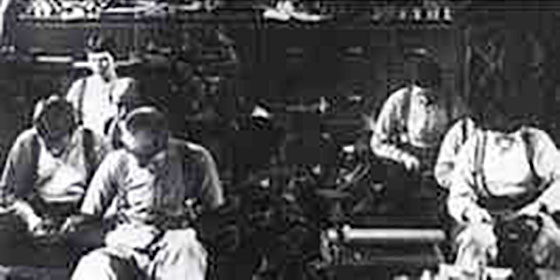
Free Labor
Inmates with mild disabilities (the "high-grades") were used as free labor to help care for others. When superintendents discovered their successful "pupils" were not welcomed back in their communities, they focused their training on skills that would make them productive workers in the institution. In this way, the institutions could demonstrate they were relieving society of a burden.
Howe and Seguin saw what was happening, but it was too late. In 1866, Howe was asked to give a keynote address for the groundbreaking of a new institution for people who were blind in Batavia, New York.
Howe pleaded with them not to open the institution, stating that the idea was misguided.
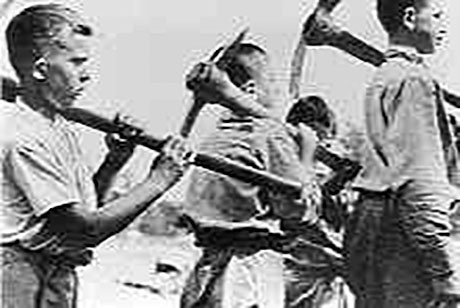
"As it is with individuals, so it is with communities; and society, moved by pity for some special form of suffering, hastens to build up establishments which sometimes increase the very evil which it wishes to lessen.
"…There are several such already in this country; and unless we take heed there will be many more. Our people have rather a passion for public institutions, and when their attention is attracted to any suffering class, they make haste to organize one for its benefit.
"…But instead of first carefully inquiring whether an institution is absolutely necessary, that is, whether there is no more natural and effectual manner of relieving the class; and afterwards, taking care that no vicious principle be incorporated into the establishment; they hastily build a great showy building, and father within its walls a crowd of persons of like conditioned infirmity; and organize as community where everything goes by clock-work and steam.
"If there be a vicious principle in the organization, as of closely associating persons who ought to live apart, it is forgotten in admiration or contrivances for making steam do what once was done by the good house-wife, with her cook and maid; and of the big bright coppers, that garnish walls, and the white floors."
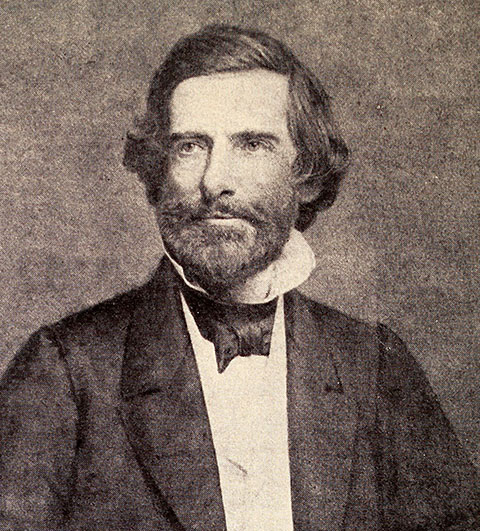
Samuel Gridley Howe
Audio: From Samuel Gridley Howe Keynote Address
Formation of Medical Association
The new institutional leaders were increasingly medical doctors, who spent much of their time managing their growing facilities. On June 6, 1876, six superintendents – Eduoard Seguin, Hervey B. Wilbur, G.A. Doran, C.T. Wilbur, H. Knight, and Isaac Kerlin – gathered in Medina, Pennsylvania and established the Association of Medical Officers of American Institutions for Idiotic and Feeble-Minded Persons (now known as the American Association for Mental Retardation, or AAMR).
As Richard Scheerenberger notes in his book, A History of Mental Retardation, the Association's primary purpose was to discuss "the causes, conditions, and statistics of idiocy, and the management, training, and education of idiots and feebleminded persons; it will also lend its influence to the establishment and fostering of institutions for this purpose."
As a result, institutions became medically oriented and the newly formed organization made clear that institutions would now have a medical focus. Persons with disabilities were viewed as patients who were sick and needed to be cured, and redefined to ensure the success and sustainability of the institution.
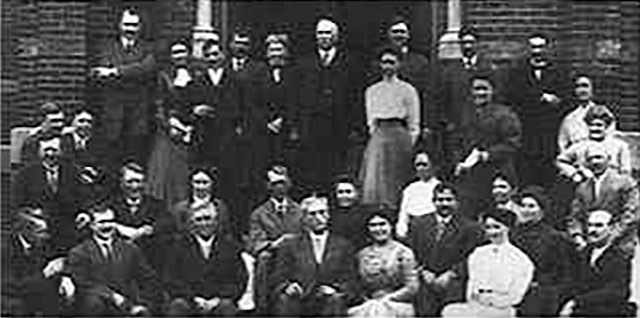
Participants at the annual meeting of the American Association for the Study of the Feeble-Minded, 1910
The Colony Plan
Superintendents believed that persons with different disabilities should be placed in different living quarters, an "epileptic colony" for persons with epilepsy, a building for "low grades," and perhaps a "girls cottage" for women with various disabilities.
During this period, many people with disabilities were considered a burden because of economic hard times. Census reports counted persons with disabilities under the same category as other social problems such as crime, prostitution, vagrancy; and concluded that many persons with "feeblemindedness" were living in the community. While parents with children with disabilities sought relief, institutions sought to expand their facilities.
The Farm Colony
Institutional expansion led to the development of farm colonies. Purchasing cheap farm land and abandoned farms in depressed rural areas, superintendents built housing for a small number of "high-grade" residents and a few staff persons.
These "mini institutions" relieved some of the overcrowding in the main institution while providing work, without pay, for the inmates. Hard physical labor was required of both staff and inmates to assure that the farm colonies produced enough food and dairy products to sustain a large institutional population.
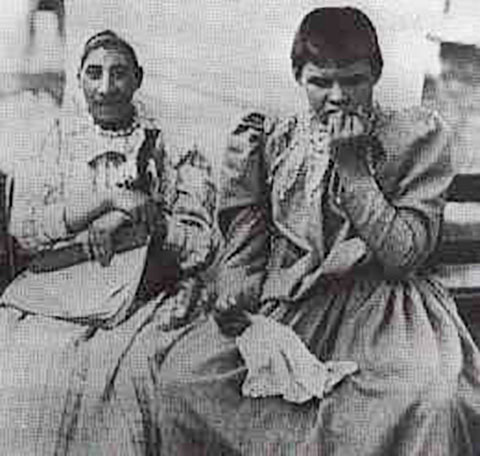
Low Grades, 1890
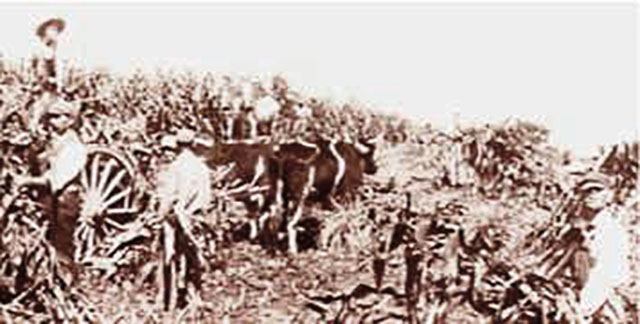
Farm Colony
